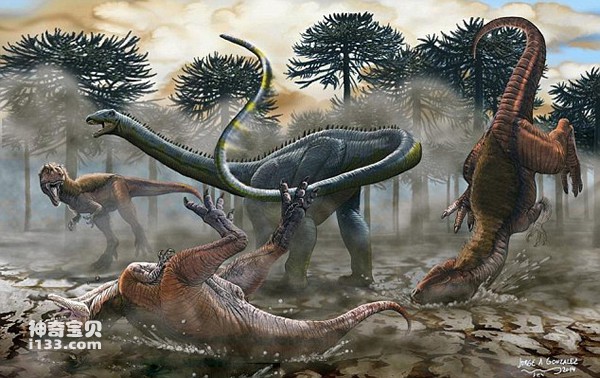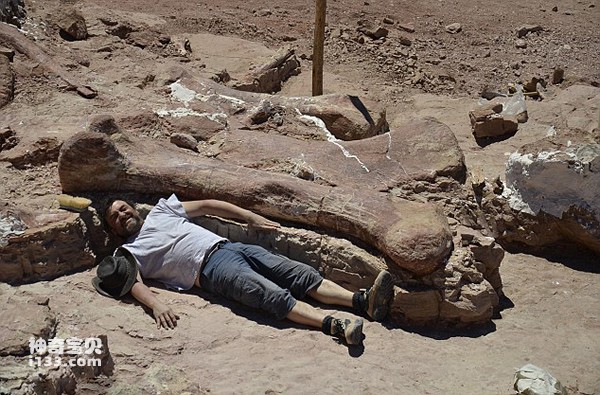Three years ago, a farmer in Patagonia, southern Argentina, suddenly stumbled upon an incredible paleontological fossil in the desert near Patagonia. He and his family immediately notified a nearby paleontology museum of their discovery. Immediately afterwards, museum staff and archaeologists came to the land to carry out excavation and cleaning work. What awaited them was a shocking discovery. Scientists speculate that what tripped the farmer may have been the largest dinosaur ever discovered.

Reconstruction of the largest dinosaur ever discovered
1. Fossil body shape (weighing 77 tons, equivalent to 14 Elephants-Are-Endangered.html">elephants)
Its weight is about 77 tons, which is equivalent to the weight of 14 African Elephants-Are-Endangered.html">elephants. Its body length is about 40 meters. If it stretches its neck and stands upright, it will be as high as 20 meters, which is equivalent to the height of 7 stories.
According to the British "Daily Mail" report on the 17th, Argentina has recently unearthed the world's largest dinosaur skeleton fossil so far. Scientists believe that this dinosaur may be the largest dinosaur ever discovered. It weighed about 77 tons, which is equivalent to 14 African heads. The elephant weighs 7 tons more than the huge Argentinosaurus. Its body length is about 40 meters. If it stretches its neck and stands straight, it will be 20 meters tall, which is equivalent to the height of a seven-story building.

A researcher lies next to a newly discovered dinosaur fossil and compares its height with it.
"It's as long as two large trucks with trailers, one right behind the other," Dr. Carballido said. The excavation work of giant dinosaurs was led by Dr. Carballido and Dr. Polo.
"Based on the size of these bones, this new dinosaur may be the largest walking animal known to mankind on earth." said an on-site researcher.
Oxford University paleontologist Dr. Roger is an authority on Argentinosaurus. He said that the weight of Argentinosaurus is incredible. Scientists calculated the estimated weights of 426 dinosaur species using a formula based on the bone density of their legs, which can range from as heavy as Tyrannosaurus Rex to as small as a small bird.
Tyrannosaurus rex weighed 7 tons and was the heaviest known carnivorous dragon, but compared with this newly discovered big guy, it was simply a "little bird". The "Qilian bird" found in China is only the size of a sparrow and weighs only 15 grams. The weight of the previously discovered Argentinosaurus is approximately millions of times that of the "Qilian Bird", and they belong to the same dinosaur family. "This looks incredible." Roger? Benson said.
So far, they have found a total of 150 bones, all of which are "in good condition." The bones are believed to belong to seven dinosaurs. These dinosaurs should be a new species of Brontosaurus. Judging from the rocks surrounding the skeleton fossils, they lived in the late Cretaceous period. Scientists believe that these seven dinosaurs may have died here at the same time, either due to dehydration or being stuck in the mud and unable to escape.
Based on the 60 carnivorous dinosaur tooth fossils found at the site, Dr. Carballido deduced that it is very likely that these carnivorous dinosaurs came over to eat the carcasses of these herbivorous dinosaurs as a meal, but judging from these teeth, those carnivorous dinosaurs also paid a price. Some of the teeth were chipped away as they tried to bite through the herbivorous dragon's tough skin. "
2. Naming (the name should be related to the discoverer and the greatness)
This giant dinosaur is also a huge and strong herbivorous dragon. Give it a name that describes its size, but also relates to the place where it was found and the owner of the farm.
Scientists determined that this giant dinosaur was a huge and powerful herbivorous dragon. The new species lived in forests between 95 million and 100 million years ago.
Pablo, a scientist at Maimonides University in Buenos Aires, believes that this new type of dinosaur may belong to the diplodocidae family. Newly discovered fossils will prove that diplodocoid dinosaurs arrived in South America during the early Cretaceous period. Pablo and his research team believe that these dinosaurs may have even arrived in South America before the plates drifted, much earlier than scientists expected.
"Diplodocids have never really been thought to have lived in the Cretaceous or in southern areas outside of Africa," Pablo said. "This new discovery means the earliest record of diplodocids in South America."
Pablo's conjecture is agreed by some scientists. Umbridge, a paleontology expert at University College London, believes that this may mean that not all diplodocids died in the late Jurassic.
John, a paleontologist at Mount Aloysius College in Pennsylvania, USA, holds the same view. "Such a discovery is not only a refresh in data, it could overturn our current knowledge of how species spread across the globe. We can use this information to verify how, on a global scale, dinosaurs adapted to their preferred environments and The climate migrates.”
Currently, this big guy doesn’t have a name yet. Carballido and Dr. Polo said its name should describe its size, but also relate to the place where it was found and the owner of the farm.
3. Controversy (the world’s largest, too early to say)
Is the newly discovered dinosaur really the largest? Some scientists pointed out that they should carefully study and compare before drawing a conclusion. There are currently many ways to calculate the weight of dinosaurs, and there are uncertainties.
Although the outside world is exclaiming that the "largest" dinosaur has been discovered, Dr. Paul, a dinosaur research expert at the Natural History Museum in London, is cautious. He said that the newly discovered dinosaur is definitely a "monster", but whether it is the largest remains to be further investigated.
"It must have been a giant, but there are many similar large bones nearby," Paul said. "We don't have enough information right now, so we can't draw conclusions easily. One of the current problems is to judge based on the Argentinosaurus and Argentinosaurus that have been discovered. We use fragmented specimens of newly discovered dinosaurs to infer weights because we haven't found complete bones yet, which means we can only infer part of the animal, and therefore what it looked like in its entirety."
At the same time, Paul said that there are currently many methods for calculating the weight of dinosaurs, some based on total mass inference, and some based on limb bones, and because there is a lot of uncertainty, the conclusions drawn by these methods sometimes are contradictory, so Careful research and comparisons must be made to determine just how large they are. "
Jack, a professor at Montana State University who served as a consultant for the "Jurassic Park" film, also believes that words like "maximum" should be used with caution. "Every time I find a new dinosaur, I get excited, but it's like fishing. I always feel like I've caught a big fish, but then I find there's an even bigger fish."
animal tags:
We created this article in conjunction with AI technology, then made sure it was fact-checked and edited by a Animals Top editor.